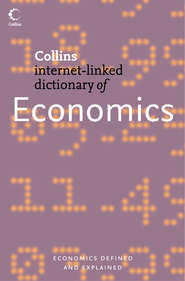
Полная версия:
Economics
Thus, looked at ‘in the round’, concentration ratios are but one aspect in examining the dynamics of a market and whether or not it exhibits competitive or monopolistic tendencies.

concentration ratio a measure of the degree of SELLER CONCENTRATION in a MARKET. The concentration ratio shows the percentage of market sales accounted for by, for example, the largest four firms or largest eight firms. The concentration ratio is derived from the market concentration curve, which can be plotted on a graph, with the horizontal scale showing the number of firms cumulated from the largest size and the vertical scale showing the cumulative percentage of market sales accounted for by particular numbers of firms. See Fig. 29. See CONCENTRATION MEASURES, MARKET STRUCTURE.
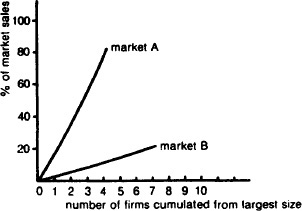
Fig. 29 Concentration ratio. Market A is here highly concentrated, with the four largest firms accounting for 80% of market sales, while market B has a relatively low level of concentration.
concerted practica a situation defined by European Union and UK competition law as one where rival firms, without engaging in formal COLLUSION (see ANTI-COMPETITIVE AGREEMENT), nonetheless informally coordinate their behaviour in respect of selling prices and discounts, and engage in market-sharing and joint capacity adjustments.
Under the EU’s Article 85 of the Treaty of Rome and the UK’s COMPETITION ACT 1998, concerted practices are prohibited outright. See COMPETITION POLICY (EU), COMPETITION POLICY (UK).
concert party a group of individuals or firms that acts ‘in concert’, pooling its various resources in order to effect the TAKEOVER of a company. See TAKEOVER BID, CITY CODE.
conciliation a procedure for settling disputes, most notably INDUSTRIAL DISPUTES, in which a neutral third party meets with the disputants and endeavours to help them resolve their differences and reach agreement through continued negotiation. In the UK the ADVISORY CONCILIATION AND ARBITRATION SERVICE acts in this capacity. See MEDIATION, ARBITRATION, INDUSTRIAL RELATIONS, COLLECTIVE BARGAINING.
condition of entry an element of MARKET STRUCTURE that refers to the ease or difficulty new suppliers face in entering a market. Market theory indicates that, at one extreme, entry may be entirely ‘free’, with, as in PERFECT COMPETITION, new suppliers being able to enter the market and compete immediately on equal terms with established firms; at the other extreme, in OLIGOPOLY and MONOPOLY markets, BARRIERS TO ENTRY operate, which severely limit the opportunity for new entry. The significance of barriers to entry in market theory is that they allow established firms to secure a long-term profit return in excess of the NORMAL PROFIT equilibrium attained under fully competitive (‘free’ entry) conditions. See MARKET ENTRY, POTENTIAL ENTRANT, LIMIT PRICING.
Confederation of British Industry (CBI) a UK organization that represents the collective interests of member companies in dealings with government and TRADE UNIONS.
congestion charge see ROAD CONGESTION.
conglomerate firm see FIRM.
consolidated fund the UK government’s account at the BANK OF ENGLAND into which it pays its TAXATION and other receipts, and which it uses to make payments.
consols abbrev. of consolidated stock; government BONDS that have an indefinite life rather than a specific maturity date. People acquire consols in order to buy a future nominal annual income without any expectation of repayment of the issue, though they can be bought and sold on the STOCK EXCHANGE. Because they are never redeemed by the government, the market value of consols can vary greatly in order to bring their EFFECTIVE INTEREST RATE in line with their NOMINAL INTEREST RATE. For example, £100 of consols with a nominal rate of interest of 5% would yield a return of £5 per year. If current market interest rates were 10%, then the market price of the consols would need to fall to £50 so that a buyer would earn an effective return on them of £5/£50 = 10%.
consortium a temporary grouping of independent firms, organizations and governments brought together to pool their resources and skills in order to undertake a particular project such as a major construction programme or the building of an aircraft, or to combine their buying power in bulk-buying factor inputs.
conspicuous consumption the CONSUMPTION of goods and services not for the UTILITY derived from their use but for the utility derived from the ostentatious exhibition of such goods and services.
A person may buy and run a Rolls-Royce motor car not just as a vehicle for transportation but because it suggests to the outside world something about the owner. That person may wish to be seen as affluent or as a person of taste. This phenomenon (known as the VEBLEN EFFECT) can be viewed as an alternative to the more usual consumption theories where the quantity of a particular good varies inversely with its price (a downward-sloping DEMAND CURVE). A conspicuous consumption good may well have an UPWARD-SLOPING DEMAND CURVE so that the quantity demanded increases with its price.
constant returns 1 (in the SHORT RUN) constant returns to the VARIABLE FACTOR INPUT that occur when additional units of variable input added to a given quantity of FIXED FACTOR INPUT generate equal increments in output. With an unchanged price for variable factor inputs, constant returns will cause the short-run unit variable cost of output to stay the same over an output range. See RETURNS TO THE VARIABLE FACTOR INPUT.
2 (in the LONG RUN) constant returns that occur when successive increases in all factor inputs generate equal increments in output. In cost terms, this means the long-run unit cost of output remains constant so long as factor input prices stay the same. See MINIMUM EFFICIENT SCALE, ECONOMICS OF SCALE.
consumer the basic consuming/demanding unit of economic theory. In economic theory, a consuming unit can be either an individual purchaser of a good or service, a HOUSEHOLD (a group of individuals who make joint purchasing decisions) or a government. See BUYER.
consumer credit LOANS made available to buyers of products to assist them in financing purchases. Consumer credit facilities include HIRE PURCHASE, INSTALMENT CREDIT, BANK LOANS and CREDIT CARDS.
Consumer Credit Act 1974 a UK Act that provides for the licensing of persons and businesses engaged in the provision of consumer CREDIT (specifically, moneylenders, pawnbrokers and INSTALMENT CREDIT traders – but not banks, which are covered by separate legislation) and the regulation of DEBTOR-CREDITOR contracts. The Act contains important provisions protecting creditors from ‘extortionate’ rates of interest. The Act is administered by the OFFICE OF FAIR TRADING in conjunction with the DEPARTMENT OF TRADE AND INDUSTRY. See CONSUMER PROTECTION, APR.
consumer durables CONSUMER GOODS, such as houses, cars, televisions, that are ‘consumed’ over relatively long periods of time rather than immediately. See Fig. 158 (b) (PRODUCT LIFE CYCLE) for details of market penetration for a number of consumer durable products. Compare CONSUMER NONDURABLES.
consumer equilibrium the point at which the consumer maximizes his TOTAL UTILITY or satisfaction from the spending of a limited (fixed) income. The economic ‘problem’ of the consumer is that he has only a limited amount of income to spend and therefore cannot buy all the goods and services he would like to have. Faced with this constraint, demand theory assumes that the goal of the consumer is to select that combination of goods, in line with his preferences, that will maximize his total utility or satisfaction. Total utility is maximized when the MARGINAL UTILITY of a penny’s worth of good X is exactly equal to the marginal utility of a penny’s worth of all the other goods purchased; or, restated, when the prices of goods are different, the marginal utilities are proportional to their respective prices. For two goods, X and Y, total utility is maximized when:

Consumer equilibrium can also be depicted graphically using INDIFFERENCE CURVE analysis. See Fig. 30. See also REVEALED PREFERENCE THEORY, PRICE EFFECT, INCOME EFFECT, SUBSTITUTION EFFECT, ECONOMIC MAN, CONSUMER RATIONALITY, PARETO OPTIMALITY.
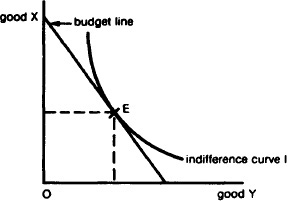
Fig. 30 Consumer equilibrium. The optimal combination of Good X and Good Y is at point E when the BUDGET LINE is tangential to indifference curve 1. At this point the slope of the budget line (the ratio of prices) is equal to the slope of the indifference curve (the ratio of marginal utilities), so the goods’ marginal utilities are proportional to their prices.
consumer goods any products, such as washing machines, beer, toys, that are purchased by consumers as opposed to businesses. Compare CAPITAL GOODS, PRODUCER GOODS.
consumerism an organized movement to protect the economic interests of CONSUMERS. The movement developed in response to the growing market power of large companies and the increasing technical complexity of products. It embraces bodies such as the Consumers’ Association in the UK, which is concerned with product testing and informing consumers through publications such as Which? Consumerism has been officially incorporated into British COMPETITION POLICY since the 1973 FAIR TRADING ACT. See CONSUMER PROTECTION.
consumer nondurables CONSUMER GOODS that yield up all their satisfaction or UTILITY at the time of consumption They include such items as beer, steak or cigarettes. Compare CONSUMER DURABLES.
consumer price index (CPI) a weighted average of the PRICES of a general ‘basket’ of goods and services bought by consumers. Each item in the index is weighted according to its relative importance in total consumers’ expenditure (see Fig. 31). Starting from a selected BASE YEAR (index value = 100), price changes are then reflected in changes in the index value over time. Thus, in the case of the UK’s CPI, the current base year is 1996 = 100; in February 2005 the index value stood at 112.2, indicating that consumer prices, on average, had risen 12% between the two dates.
Since December 2003 the CPI has been used by the UK government as a measure of the rate of INFLATION in the economy for the purposes of applying macroeconomic policy in general and monetary policy in particular (see MONETARY POLICY COMMITTEE). Previously, the RETAIL PRICE INDEX (RPI) was used for this purpose, but the CPI measure was adopted to harmonize the way the UK measured its inflation rate with that of other countries in the EUROPEAN UNION.
consumer protection measures taken by the government and independent bodies such as the Consumers’ Association in the UK to protect consumers against unscrupulous trade practices such as false descriptions of goods, incorrect weights and measures, misleading prices and defective goods. See TRADE DESCRIPTIONS ACT 1968, WEIGHTS AND MEASURES ACT 1963, CONSUMER CREDIT ACT 1974, PRICE MARKETING (BARGAIN OFFERS) ORDER 1979, OFFICE OF FAIR TRADING, COMPETITION POLICY, CONSUMERISM.
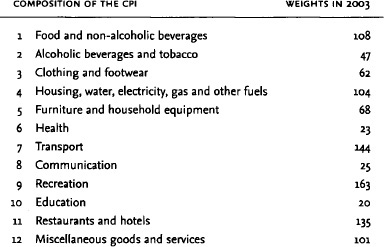
Fig. 31 Consumer price Index. Source: Office of National Statistics.
consumer rationality or economic rationality the assumption, in demand theory, that CONSUMERS attempt to obtain the greatest possible satisfaction from the money resources they have available when making purchases. Because economic theory tends to sum household demands in constructing market DEMAND CURVES, it is not important if a few households do not conform to rational behaviour as long as the majority of consumers or households act rationally. See ECONOMIC MAN.
consumer sovereignty the power of CONSUMERS to determine what is produced since they are the ultimate purchasers of goods and services. In general terms, if consumers demand more of a good then more of it will be supplied. This implies that PRODUCERS are ‘passive agents’ in the PRICE SYSTEM, simply responding to what consumers want. In certain kinds of market, however, notably, OLIGOPOLY and MONOPOLY, producers are so powerful vis-à-vis consumers that it is they who effectively determine the range of choice open to the consumer. See REVISED SEQUENCE.
consumers’ surplus the extra satisfaction or UTILITY gained by consumers from paying an actual price for a good that is lower than that which they would have been prepared to pay. See Fig. 32 (a). The consumers’ surplus is maximized only in PERFECT COMPETITION, where price is determined by the free play of market demand and supply forces and all consumers pay the same price. Where market price is not determined by demand and supply forces in competitive market conditions but is instead determined administratively by a profit-maximizing MONOPOLIST, then the resulting restriction in market output and the increase in market price cause a loss of consumer surplus, indicated by the shaded area PPmXE in Fig. 32 (b). If a DISCRIMINATING MONOPOLIST were able to charge a separate price to each consumer that reflected the maximum amount that the consumer was prepared to pay, then the monopolist would be able to appropriate all the consumer surplus in the form of sales revenue.
Business strategists can use the concept of the consumers’ surplus to increase the firm’s profit (see VALUE-CREATED MODEL). To illustrate: you are a Manchester United football fan; tickets for a home game are currently priced at £50 but you would be willing to pay £75. Hence, you have ‘received’ as a consumer ‘perceived benefit’ or ‘surplus’ of £25 over and above the price actually charged. Manchester United, however, instead of charging a single price of £50 could segment its market by charging different prices for admission to different parts of the ground (see PRICE DISCRIMINATION, MARKET SEGMENTATION) in order to ‘capture’ more of the consumers’ surplus for itself. Thus, it could continue to charge the ‘basic’ price of £50 for admission to certain parts of the ground, £75 for seating in the main stand and £120 for an ‘executive box’ seat. Compare PRODUCERS’ SURPLUS. See DIMINISHING MARGINAL UTILITY, DEADWEIGHT LOSS.
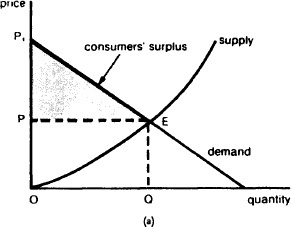
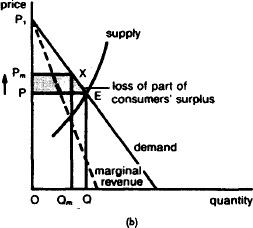
Fig. 32 Consumers’ surplus. (a) At the EQUILIBRIUM PRICE OP, utility from the marginal unit of the good is just equal to its price; all previous units yield an amount of utility that is greater than the amount paid by the consumer, insofar as consumers would have been prepared to pay more for these intramarginal units than the market price. The total consumer surplus is represented by the shaded area PEP1 (b)The loss of consumers’ surplus because of monopoly.
consumption the satisfaction obtained by CONSUMERS from the use of goods and services. Certain CONSUMER DURABLE products, like washing machines, are consumed over a longish period of time, while other products, like cakes, are consumed immediately after purchase. The DEMAND CURVE for a particular product reflects consumers’ satisfactions from consuming it. See WANTS, DEMAND.
consumption expenditure the proportion of NATIONAL INCOME or DISPOSABLE INCOME spent by HOUSEHOLDS on final goods and services. Consumption expenditure is the largest component of AGGREGATE DEMAND and spending in the CIRCULAR FLOW OF NATIONAL INCOME. It is one of the most stable components of aggregate demand, showing little fluctuation from period to period.
In 2003, consumption expenditure accounted for 52% of gross final expenditure (GFE) on domestically produced output (GFE minus imports = GROSS DOMESTIC PRODUCT). See Fig. 132 (b), NATIONAL INCOME ACCOUNTS. See CONSUMPTION SCHEDULE, VEBLEN EFFECT.
consumption function a statement of the general relationship between the dependent variable, CONSUMPTION EXPENDITURE, and the various independent variables that determine consumption, such as current DISPOSABLE INCOME and income from previous periods and WEALTH. See CONSUMPTION SCHEDULE, LIFE-CYCLE HYPOTHESIS, PERMANENT-INCOME HYPOTHESIS, WEALTH EFFECT.
consumption possibility line see BUDGET LINE.
consumption schedule a schedule depicting the relationship between CONSUMPTION EXPENDITURE and the level of NATIONAL INCOME or DISPOSABLE INCOME, also called consumption function. At low levels of disposable income, households consume more than their current income (see DISSAVING), drawing on past savings, borrowing or selling assets in order to maintain consumption at some desired minimum level (AUTONOMOUS CONSUMPTION). At higher levels of disposable income, they consume a part of their current income and save the rest (see SAVING). See Fig. 33. See INDUCED CONSUMPTION.
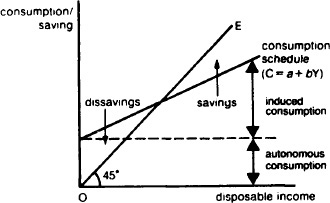
Fig. 33 Consumption schedule. A simple consumption schedule that takes the linear form C = a + bY, where C is consumption and a is the minimum level of consumption expenditure at zero-disposable income (autonomous consumption). Thereafter consumption expenditure increases as income rises (induced consumption), and b is the proportion of each extra £ (pound) of disposable income that is spent. The 45-degree line OE shows what consumption expenditure would have been had it exactly matched disposable income. The difference between OE and the consumption schedule indicates the extent of dissavings or SAVINGS at various income levels. The slope of the consumption schedule is equal to the MARGINAL PROPENSITY TO CONSUME. See SAVINGS SCHEDULE, LIEE-CYCIE HYPOTHESIS, PERMANENT-INCOME HYPOTHESIS.
contestable market a MARKET where new entrants face costs similar to those of established firms and where, on leaving, firms are able to recoup their capital costs, less depreciation. Consequently, it is not possible for established firms to earn ABOVE NORMAL PROFIT as this will be eroded by the entry of new firms, or, alternatively, the mere threat of such new entry may be sufficient to ensure that established firms set prices that yield them only a NORMAL PROFIT return. Perfectly competitive markets (see PERFECT COMPETITION) are all contestable, but even some oligopolistic markets (see OLIGOPOLY) may be contestable if entry and exit are easily affected.
In recent times many markets have been opened up by a number of developments, including increasing international competition as trade barriers have been reduced, the introduction of FLEXIBLE MANUFACTURING SYSTEMS and E-COMMERCE trading on the INTERNET. See WORKABLE COMPETITION, CONDITION OF ENTRY, BARRIERS TO ENTRY, BARRIERS TO EXIT.
contingency theory the proposition that the best organization structure for a particular firm depends upon the specific circumstances that it faces and that there is no uniformly best organization structure for all firms in all circumstances. The appropriate organizational structure for a firm in particular circumstances seeks to balance ECONOMIES OF SCALE and ECONOMIES OF SCOPE in production and distribution; TRANSACTION COSTS; AGENCY COSTS; and information flows.
contract a legally enforceable agreement between two or more people or firms generally relating to a TRANSACTION for the purchase or sale of goods and services. Contracts may take a standardized form, with the same conditions of exchange being applied to every one of a large number of contracts, for example, airline ticket contracts. Alternatively, contracts may be lengthy and complicated because they are carefully tailored to a specific transaction such as the contract to build an office block for a client.
A complete contract stipulates each party’s responsibilities and rights for every contingency that could conceivably arise during the transaction. Such a complete contract would bind the parties to particular courses of action as the transaction unfolds, with neither party having any freedom to exploit weaknesses in the other’s position. It is difficult to develop complete contracts since parties to the contract must be able to specify every possible contingency and the required responses by the contracting parties, to stipulate what constitutes satisfactory performance, to measure performance, to make the contract enforceable and to have access to complete information about circumstances surrounding the contract.
In practice, most contracts are incomplete contracts in which the precise terms of the contract relating to product specifications, supply or delivery terms cannot be fully specified. In such situations, one or other parties to the agreement may be tempted to take advantage of the open-endedness or ambiguity of the contract at the expense of the other party. See ADVERSE SELECTION, MORAL HAZARD, ASYMMETRY OF INFORMATION, ASSET SPECIFICITY.
contract curve see EDGEWORTH BOX.
contractor a person or firm that enters into a CONTRACT enforceable in law with another person or firm to supply goods or services. For example, a house builder may employ contractors to undertake the plumbing work involved in the construction of houses rather than do this work itself. The plumbing contractor would provide, for the contract price, all piping, wire, tanks, etc., needed, plus the specialist workers to install them. In turn, the plumber may enter into an agreement with a subcontractor to install the time clocks and electrical controls for the central heating system.
contribution the difference between a product’s SALES REVENUE and its VARIABLE COSTS. If total contributions are just large enough to cover FIXED COSTS then the producer BREAKS EVEN; if contributions are less than fixed costs, the producer makes a LOSS; while if contributions exceed fixed costs then the producer makes a PROFIT. See LOSS MINIMIZATION, MARGINAL COST PRICING.
control loss see AGENCY COST.
conventional sequence see REVISED SEQUENCE.
convertibility the extent to which one foreign currency or INTERNATIONAL RESERVE ASSET can be exchanged for some other foreign currency or international reserve asset.
International trade and investment opportunities are maximized when the currencies used to finance them are fully convertible, i.e. free of FOREIGN EXCHANGE CONTROL restrictions.
convertible loans long-term LOANS to a JOINT-STOCK COMPANY that may be converted at the option of the lender into ORDINARY SHARES at a predetermined share price.
conveyance a document that transfers the legal ownership of land and buildings from one person/business to another person/business. See MORTGAGE.
cooperation 1 the process whereby FIRMS seek to coordinate their pricing and output policies rather than compete with one another in order to achieve JOINT-PROFIT MAXIMIZATION. See MUTUAL INTERDEPENDENCE, OLIGOPOLY.
2 the process whereby individuals coordinate their work in TEAMS.



